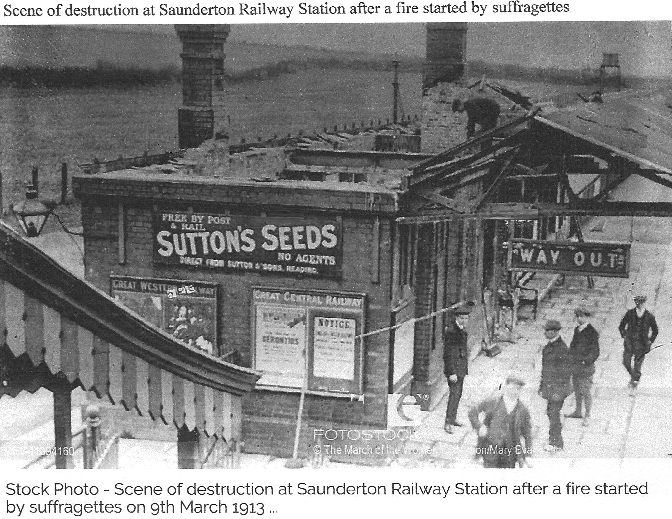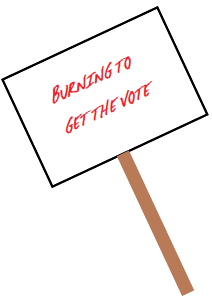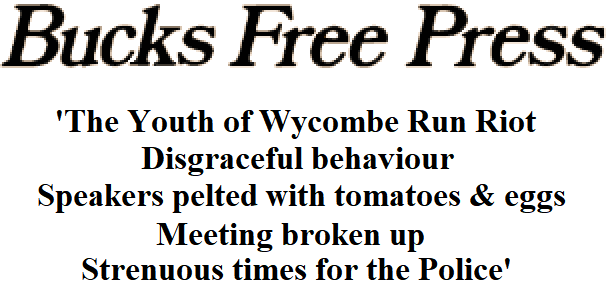

Researched by Rita Probert
On this page
Exactly 107 years ago The Suffragette Movement finally achieved their goal. There was both a militant and peaceful Suffrage movement. This is a history of local events involving the movement.
On Thursday, March 6th 1913 Miss G.N.C. Coyle opened a campaign in High Wycombe under the auspices of the Wycombe Branch of the National Union of Women's Suffrage Societies. Miss Coyle at her opening meeting said she proposed to speak in the open air each day for a quarter of an hour, during the tea interval between the factories of William Birch Ltd and Messrs Rowland & Son in Denmark Street.
At the first meeting there was some good-natured chaff from a crowd of some 300 or 400 work people and children. Friday afternoon's meeting was not so pleasant, pieces of orange peel and banana skins being thrown at the speaker. On Monday the crowd was larger than ever, but Miss Coyle did not put in an appearance, but on Tuesday afternoon, the 11th, she did and used a chair as a platform. At the outset she told her hearers she would give them 5 minutes to ask questions. Proceeding with her address she had only just commenced to deal with 'Votes for Women from an economic standpoint' when it became almost impossible to make her voice heard above the din.
She did, however, answer the first query - "What about the fire at Saunderton?", but this was quickly followed by a remark from someone in crowd "You ought to have been thrown in the fire!".
Whilst one woman shouted, "Set 'em alight!".
These remarks caused a considerable amount of merriment, but Miss Coyle, when order was restored, declared that the party she represented had nothing whatsoever to do with the Saunderton Station fire. She said people were apt to mix the non-militants with the militant Suffragettes and we are not militant.
By this time the youthful portion of the crowd had got out of hand and Miss Coyle was hustled from her chair. She climbed back on, but was pushed off it again, was rescued by Mr Berney and sought refuge in the shop premises of Mr. H. Aldridge at the corner of Temple Street. The crowd waited for some moments and then sang, 'Tell me the old, old story'. After a few more ugly rushes, Chief Constable Sparling appeared on the scene and was loudly cheered. The warning whistles in the adjacent factories sounded for the resumption of work and very quickly the crowd dispersed. Miss Coyle told a representative of the Bucks Free Press that it was the youthful element that had broken up the meeting and thought the fire at Saunderton was at the bottom of the hostile demonstration.
Bucks Free Press March 10th 1913
The neighbourhood of Saunderton was aroused in the early hours of Monday morning by a fire at the Railway Station, which has created widespread interest, chiefly on account that it was the work of militant Suffragettes.

The station is situated midway between High Wycombe & Princes Risborough on the Great Western & Great Central Joint Railway and serves the villages of Saunderton, Lacey Green & Bledlow Ridge. It is accessible from the high road meadow land from Slough Hill and the road that runs alongside The Golden Cross public house.
Sunday night was very dark and stormy and owing to the small amount of traffic the Railway Authorities do not deem it necessary to keep anyone on duty all night. There is no resident police officer at Saunderton, the nearest Constables being stationed at Bledlow Ridge, Lacey Green and West Wycombe. When Mr Kitson, the Station Master, left on Sunday, all was apparently safe.
Soon after 1.00am on Monday, Mrs Harman who resides in a cottage about 50 yards from the railway bank, was aroused by what she thought to be the sound of hailstones striking against her bedroom window; they were in fact fragments from the burning railway station, carried in the direction of her cottage by the strong wind. It was evident that the station had been burning for some time and Mrs Harman at once called Mr Kitson who lives in a house a few yards nearer The Golden Cross. He was soon on the scene and from the signal box telephoned for the Princes Risborough and High Wycombe Fire Brigades. Mr A.G. Smith, a railway packer from Bradenham was also aroused by the barking of his dog and from his window saw the glare of fire. He ran to the residence of the ganger and both men were soon on the spot. The station was said to be like a furnace.
Before the arrival of the Brigades, Mr C.D. Preston, Master of the Workhouse, Saunderton and Mr Jenner, the Porter, tried to extinguish the flames by the aid of a hand grenade, but the fire was too fierce for the chemicals to have any effect. High Wycombe Brigade was first on the scene with their steamer, but there was not enough water as the chief supply was the adjacent pond, which soon emptied after Princes Risborough Brigade arrived.
A further supply of water was obtained from the 1,500 gallon tank in front of Saunderton Workhouse. The fire was eventually under control, but all that remained of the railway station was a blackened exterior. Curiously, the station clock which hung on the wall in the centre of the building was still going and showing the correct time.


The contents of the parcels office were completely destroyed; all that remained of the safe including gold, silver and copper coins was a mass of melted metal. Only the handlebars of the porter, Mr William Figg's bicycle was left. All the furniture made of pitch pine in the waiting room had only added to the ferocity of the fire, leaving just the fire grates. The sweet machines and their contents had melted into heaps of burnt sugar and chocolate.
As daylight dawned important discoveries were made. Two placards -- one on the spikes of the iron railings near the entrance to the station and the other picked up between the railway lines. Holes in the latter showed that it had been suspended on the railings and had been blown off by the fierce wind.
Major Otway Mayne, Chief Constable of the Buckinghamshire Constabulary attended the scene, along with Superintendent Trevener of High Wycombe and other Police Constables, including two plain clothes officers and Constable Cox of Lacey Green. A conference was held and it was concluded that the fire was the work of militant Suffragettes.
No one in the area had heard or seen a motor car, but members of the Wycombe Fire Brigade said they had passed a woman on the Bradenham road. From another source it was learned that two young women, strangers to the area, had called on previous occasions to partake of tea at a house not far from the fire. After paying their bills they went away without giving any indication of why they were in the area.
On 22nd July 1913 about 50 women arrived in Princes Risborough. They were from the National Union of Women's Suffrage Societies to highlight popular support for 'Votes for Women'. Some had come all the way from Carlisle aiming to join a very large rally In Hyde Park, London. They arrived by car, bicycle, horse or caravan, as well as many on foot.
After a well-received meeting in Princes Risborough Market Square under the town clock, they lunched at The George & Dragon before mustering in the pub's cobbled yard at the rear before marching towards High Wycombe. After a roll-call they fell in behind the Wycombe Town Band. All along the West Wycombe Road the crowds grew more numerous and more hostile. Frogmoor was where they planned to hold a meeting, but this had to be abandoned amidst scenes of riot.
They eventually joined up with other 'pilgrims' in Hyde Park on 26th July. The crowd there was estimated to be around 100,000.
In general, the population was hostile to Suffragettes and in High Wycombe, particularly so. In July 1913 during the march from Carlisle to London the reception was reasonable in Oxford, Thame and Princes Risborough, however, before they left West Wycombe there were indications that the marchers would encounter trouble before reaching High Wycombe.
The report from a trustworthy source proved to be correct; there had been an exceptional demand in the town for rotten eggs and tomatoes!

The full report in the newspaper justified that unprecedented five-decker headline.
'As Wycombe was approached the road was mainly occupied by the youths of the town. Near Sands Lane, Police Sergeant Haynes came in contact with the gang and quickly scattered them in all directions.
The procession was led by Mrs Harley (the recognised leader), Miss Harley, Miss Dove (Head Mistress of Wycombe Abbey Girls' School) and others. The Wycombe Town Band headed the procession and played suitable music en route.
Along the West Wycombe Road the crowd became dense. Here & there the marchers were greeted by waving handkerchiefs and cheers, but this only gave the youth's new opportunities to jeer and hoot.
It was estimated that there was a crowd of 10,000 in Oxford Road and the Fountain (Frogmoor), where the meeting and speeches were to take place, was packed almost to suffocation. It was at this juncture that the rowdies let themselves go. The police seemed powerless to act and Chief Constable Sparling soon had his reserve men assist. No sooner had the speakers ascended the platform (a lorry) than there was an outburst of hostility.
It was apparent that there would be no meeting owing to the continual booing and shouting. A Mr J. T. Edgerley who was standing by the lorry vainly implored the crowd to act like Englishmen, to no avail and, amidst the din, more rotten eggs and tomatoes were thrown at the speakers and some of the missiles took effect. There were also instances of sawdust-saturated oil and bags of flour being thrown. Banners were seized and torn to ribbons. The police were pushed from pillar to post: attempts were made to overturn the lorry. The meeting was abandoned and it was at great risk the speakers got away.
Miss Dove went to Temple End and had to seek shelter in a private residence. Others escaped through Priory Avenue, Priory Road and Hughenden Road, but were followed by the angry mob. Others tried to seek shelter in Castle Street. In the High Street, a Doctor Fleck escorted two of the speakers to his residence and then addressed the assembly reminding the crowd that the 'pilgrims' on the march were law-abiding and not militant Suffragettes.....adding that he hoped the residents of High Wycombe were also.
These words acted like magic and after Mrs Harley, from the marchers, forced home some of the points and reason for the campaign, she was enthusiastically received. After this brief respite, however, the crowd had heard that some of the marchers' motors and luggage were in Messrs Davenport & Vernon's garage and in a short time Corporation Street was again packed with people.
Under the cover of darkness a number of stones were thrown and windows of the garage broken. At last Police charged the crowd and eventually succeeded. By 11pm the streets were more or less no more lively than on ordinary evenings. Thus ended one of the most disgraceful scenes ever witnessed in Wycombe'.
The Suffragette Movement in High Wycombe was led by Dame Frances Dove, a former Councillor and Headmistress of Wycombe Abbey Girls' School. Miss Dove was a trail-blazer who promoted equal opportunities for women. She was born in Bordeaux, France in 1847, the eldest of ten children of Reverend John Dove of Cowbit, Lincolnshire.
Frances Dove attended Girton College, Cambridge, but as the University refused to award women Degrees, she received hers in Dublin. She later became Assistant Mistress at Cheltenham Ladies' College in 1877 and founded Wycombe Abbey Girls' School in 1896.
In 1928, Frances Dove was made Dame Commander of the Order of the British Empire and died in 1942 shortly before her 95th birthday.
Composed by Hubert Parry in 1916 to 'brace the spirit of the nation in the depths of the First World War'. The lyrics were from a poem by William Blake and the title was changed to 'Jerusalem' in 1918.
The National Union of Women's Suffrage Societies used the song at a Suffragettes' Demonstration Concert on 13th March that year. Parry was delighted it was chosen and orchestrated the piece for the concert: it had originally been for voices and organ.
After the concert Millicent Fawcett of the N.U.W.S.S., asked Parry if it might become the Women's Voters' hymn. He wrote back, "l wish indeed it might become the Women's Voters' hymn as you suggest. People seem to enjoy singing it and having the vote ought to diffuse a good deal of joy, so they should combine happily".
In the autumn of 1918 Parry contracted Spanish Flu during the global pandemic and died on 7th October. He was buried in St Paul's Cathedral.
'Jerusalem' was adopted in 1924 as the anthem of the Women's Institute and sung at every meeting.
Their motto was 'Deeds not words'
The Suffragettes adopted the colour scheme of violet, green & white to represent their cause. Each had a meaning:
Violet - Dignity
White - Purity
Green - Hope
These were used for sashes, banners and jewellery, some of the latter produced by the Arts & Crafts Movement. Brooches, badges, pendants & ear-rings were popular items.
Suffragettes were encouraged by Emmeline Pankhurst to wear particularly feminine Edwardian clothing - lace blouses, hats decorated with flowers and ribbons etc, when taking part in marches & demonstrations. This prompted many London & suburban department stores to develop a marketing strategy in tune with the Suffragette cause. Advertisements for clothing, hats and lingerie appeared in newspapers and magazines. Fashions of the time also required a good corset as a basis for outer garments!
September 24th 1908
The statement that the hygienic condition of the prison is appalling is quite contrary to fact and quite inconsistent with the health standard maintained amongst prisoners. The water jugs, which are filled by prisoners themselves at the taps, contain 5 pints (good). They have been filled for the suffragettes regularly three times a day, and at any other time at the request of the prisoners. There is no stinting of water for any prisoner.
Prisoners are never given dirty clothes to wear. It is quite untrue that combs with vermin in them were ever supplied to them. All combs and brushes issued to them were clean, and generally new. As an illustration of the complaint l may point out that on one occasion a Suffragette complained to the Chairman of the Visiting Committee that her hair brush had vermin in it. The brush in question had actually been issued new from Store and a careful examination of it satisfied the Chairman that the 'vermin' was merely a speck of white in the make of the bristle. A few cases, l may add, have been found amongst former batches of Suffragettes who had verminous heads on reception.
It is not correct that only one visit out of the cell is allowed in 24 hours at a fixed time. This has never been the case. I quote from the letter of a former prisoner, Sarah Benett, addressed to the Matron in February 1908 the following on this subject:- " I felt for them (the wardens) very much in the miles they had to walk answering bells in the evening".
Neither is it correct that cell chambers are emptied only once in 24 hours.
None of the batches of Suffragettes have had socks or stockings to darn recently. The first or second batch a year or two ago may have had some given to them for repair, but socks and stockings are invariably washed before they are sent out for this purpose. l cannot recall any complaint being made of such a grievance at the time, and it is obviously very difficult to meet such complaints after so long an interval - a remark which applies equally to many of the allegations that are made by their advocates outside rather than by the prisoners themselves.
l should like to add that l have always endeavoured to show these prisoners consideration and forbearance, that I do not know any instance of brutality or anything like it shown by wardresses, although the conduct of these prisoners has often been of a kind to try the temper of officers very severely.
(Signed): M. Dunton(?) Governor
(This is a transcript of original letter of complaint)